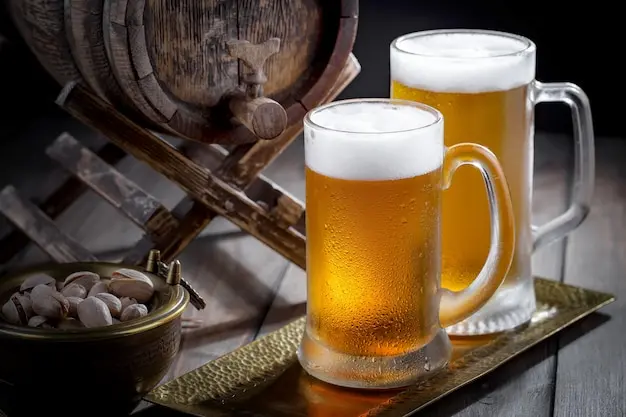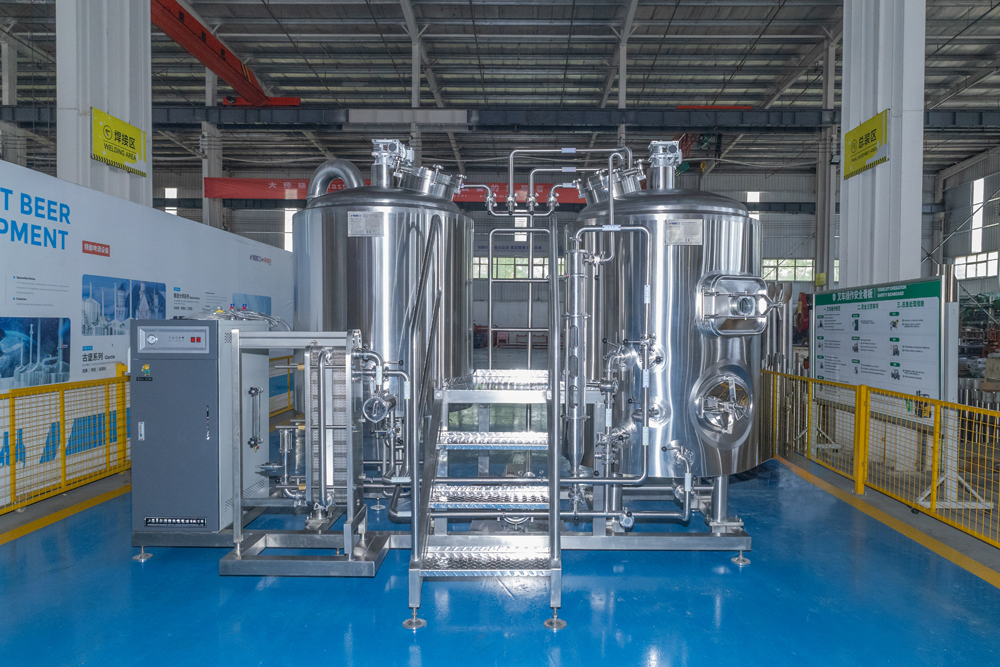In today’s beverage market, the competition between craft beer and commercial beer is becoming more and more fierce. Consumers’ tastes and preferences are becoming increasingly diverse, and many people are beginning to pay attention to the stories behind beer, brewing processes, and unique flavor experiences. The competition between craft beer and industrial beer has always been discussed among beer lovers, brewers, and bar owners. Both have their unique advantages, targeting different customer preferences and experiences. Understanding the nuances and differences between these two beers can help you make an informed decision.

Different definitions
What is craft beer?
Craft beer usually refers to beer produced by small independent breweries. These breweries usually emphasize hand-brewing, the use of high-quality raw materials, and innovative flavors and styles. Craft beer emphasizes diversity, miniaturization, boutique, and localization. Almost all craft breweries must be microbreweries when they start, and many breweries can only be microbreweries forever because of their professionalism. In the United States, the government requires that craft breweries cannot be controlled by industrial breweries, or the shares of industrial breweries cannot exceed 25%.
Features of craft beer:
Small-scale production: Craft beer is usually made in small breweries with a relatively small production scale, which allows brewers to pay more attention to the quality and uniqueness of each batch of beer.
Hand-made brewing: Compared with industrialized large-scale production, craft beer emphasizes handcrafts. Brewers will put their heart and soul into every link to ensure the uniqueness and complexity of the flavor.
Diverse flavors: Craft beer often uses a variety of different malts, hops, and yeasts, and even adds fruits, spices, or other unique ingredients to create a rich and diverse flavor experience.
Independence: Craft beer is usually produced by independent breweries, which are not controlled by large alcohol groups and maintain autonomy and innovation.
Culture and community: Craft beer is not only a drink, but also a cultural phenomenon. Many craft breweries actively participate in local community activities, establish close ties with consumers, and create a unique brand story and social atmosphere.
Quality first: Craft beer pays attention to the quality of raw materials and every detail of the brewing process, and usually pursues higher brewing standards to meet consumers’ high requirements for taste and flavor.
craft beer
What is commercial beer?
Commercial beer refers to beer produced by large industrial breweries, which usually pursue efficient and large-scale production to meet the needs of the mass market. The focus is on quickly producing large quantities of beer to meet high demand. The selection of raw materials usually focuses on cost-effectiveness and output, and additives and preservatives are sometimes used to extend the shelf life and maintain consistency between batches. Industrial beer has a more uniform taste because the brewing process and style of industrial beer are relatively simple and the fermentation time is short.
Characteristics of commercial beer:
Scaled production: Commercial beer is usually produced in large-scale breweries to meet the needs of a wide range of markets. This large-scale production makes the cost of each batch of beer lower and the price more competitive.
Standardized recipe: To ensure consistency in taste, commercial beer uses standardized production processes and recipes. This means that consumers can get a similar taste experience no matter when and where they buy it.
Wide distribution: Commercial beer is usually widely distributed through large retailers, supermarkets, and catering channels, making it easily accessible in the market and suitable for mass consumption.
Popular taste: Commercial beer often pursues popular tastes, usually with a light and refreshing style to suit a wider range of consumer preferences.
Brand awareness: Many commercial beer brands enjoy high popularity in the market and rely on advertising and promotional strategies to attract consumers.
Economic benefits: The production of commercial beer often pursues efficiency and cost control, which makes it price-advantageous and suitable for consumers with limited budgets.

First, the brewing materials of craft beer and ordinary beer are different. Beer is a low-alcohol fermented wine containing carbon dioxide, which is made from grains and water as the main raw materials, and hops (or hop products) are fermented by yeast.
Beer can usually be divided into craft beer and industrial beer according to the raw materials and fermentation process.
1. Craft beer: brewed with only malt, hops, yeast and water, without any artificial additives. Compared to industrial beers, with more malt and more hops added, the resulting wort is more concentrated. Usually, craft beer does not need to consider the cost too much when brewing, and most of them will choose the best raw materials for brewing.
2. Industrial beer: It is also brewed with malt, hops, yeast and water, but in pursuit of cost, more raw materials such as rice, corn and starch are used to replace malt. The resulting beer has a very low wort concentration and a bland taste.
Second, the fermentation process is different
The fermentation process of craft beer and industrial beer is also different. Usually, craft beer adopts the Ales process (Ales, upper fermentation process), and industrial beer adopts the Lager process (Larges, lower fermentation process). The main difference is the location of the yeast during fermentation and the fermentation temperature.
1. Craft beer: mostly ale process, the yeast works at the top of the fermentation tank and floats above the liquor, and the fermentation temperature is generally controlled at 10-20 °C. Fermenters are usually small and are not filtered and sterilized after fermentation.
2. Industrial beer: Most of it is a lager process. The yeast works at the bottom of the fermentation tank and sinks under the liquor. The fermentation temperature is generally controlled below 10 °C. The fermentation tank is larger, and filtration and pasteurization are usually used after fermentation to increase the shelf life (shelf life) of the beer.
Third, the fermentation time is different
In addition to the differences in the fermentation process between craft beer and industrial beer, the fermentation time is also very different.
1. Craft beer: Because there is no need to worry too much about the cost, the fermentation time is often not paid much attention to, and the time cost is not considered too much. The most traditional craft beer fermentation time can be as long as 15 days – 2 months, so that the beer is fully fermented, the wort concentration is higher, and the flavor is stronger.
2. Industrial beer: For industrial beer, time is money, so the fermentation time of industrial beer is usually only about 7 days, so the fermentation will not be particularly sufficient, resulting in a low concentration of wort and a lighter flavor.
Fourth, the history of development The fermentation history of different craft beers is longer than that of industrial beers.
Craft beers have appeared long before industrial beers.
1. Craft beer: In the beginning, ale (craft beer) was produced by women to protect their families to survive in harsh environments (such as plague, famine, polluted water, etc.). During the Middle Ages, large numbers of people died from the plague, and the church took over the production of beer.
Due to the huge increase in market demand for beer and high profits, craft beer has developed rapidly. At that time, many European royal families also established their own royal breweries to brew craft beer. But with the advent of refrigeration equipment, industrial beer that is stable in quality, not easy to spoil, and suitable for transportation has become popular. Coupled with the prosperity of glass products, the turbid ale in the transparent glass is not very pleasing, and people are more and more fond of lager beer (mostly industrial beer).
2. Industrial beer: In the 1940s, beer brewers in Bavaria, Germany brought the beer fermentation process to Pilsen, Czech Republic, and produced the world’s earliest golden beer, Pilsen beer (industrial beer), with refrigeration equipment. The emergence of this beer with stable quality and non-deterioration suitable for large-scale industrial production and transportation is popular in the world. As transportation improved, Pilsner and the Pilsner brewing method soon spread throughout Central Europe.
Later, the popular European beer was brought to the United States by immigrants, and gradually Americans gradually liked this beer, but because the United States had less barley, corn was gradually used instead of barley to brew beer, and later evolved into using rice or barley. Starch, etc., instead of barley brewing beer, has formed the American industrial beer seen on the market today.
Fifth, styles and nutritional value are different
1. Craft beer: Craft beer usually adds a large variety and quantity of malt, yeast and hops, and can be brewed in different styles, including fragrant wheat beer, thick dark beer, amber beer and fruit beer. Etc., there are nearly 100 styles of craft beer in the world divided by type. These craft beers have rich aroma, high content of wort, thick and full taste, higher nutritional value and high price. Most craft beers have an alcohol content of more than 11 degrees, and some fortified craft beers can reach 20 degrees.
2. Industrial beer: In order to unify the taste of the finished product, the brewing process and style of industrial beer are usually single, and the fermentation time is extremely short, so industrial beer has a light taste, more bubbles, low wort concentration, low hop content and low alcohol content. and other characteristics, its natural nutritional value and price are also lower.
Sixth, the storage time is different
1. Craft beer: Most craft beers are not filtered and sterilized, so craft beers are less resistant to preservation. Most craft beers have a short shelf life, some only a few tens of days.2. Industrial beer: In the later stage of fermentation, industrial beer is often filtered and pasteurized, and has a long shelf life. The general shelf life of industrial beer is 1-2 years, and some can even reach decades.
Today’s craft brewers, no matter if they’re starting off in their garage or looking to build a multi-barrel production brewery, are facing an increase in demand and a constant threat of competition. Fortunately, at Specialty Equipment Company, we offer a range of specialty beer brewing equipment can help turn your passion for brewing into a business.

